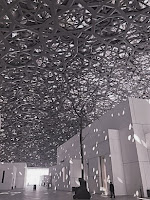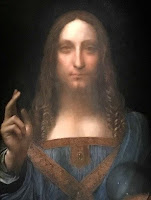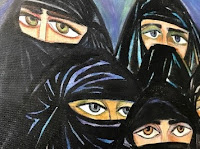The following is a sponsored post by the International Society of Appraisers / ISA Affinity Business Partner (ABP), FindArtExperts.com.
While planning a marketing and relationship-building trip to Art Dubai 2018, Find Art Experts received a personal invitation by Emirati and French representatives of the Louvre Abu Dhabi to attend a presentation titled A Unique Cross-Cultural Collaboration. The invitation represents an important turning point for international recognition of America's art appraisal community.
Find Art Experts visited Art Dubai as part of its global expansion plans to introduce American appraisers to the Middle Eastern art market. Future marketing endeavors on the part of Find Art Experts include visits and meetings during Art Basel in America at Miami Beach in December 2018, Italy's Venice Biennale in May 2019, and a return to Art Dubai in March 2019. We are making our presence known in these markets and art fairs to open our 15,000-member database to markets all over the globe.
Appraisers in America may be surprised to learn that reaching global markets is not as daunting as it initially seems. Like any endeavor, there are steps to take and pitfalls to avoid. We learned:
-
Marketing to a global customer base can cost a lot of time and money
-
The right help can slash the time it takes to educate consumers about your service
-
Focusing on markets that provide the best return on a minimal investment is a good strategy
-
To avoid chasing too many opportunities and to stay true to our service
-
The importance of educating ourselves about a region's cultural heritage and the unique needs of a new clientele
Our trip to the United Arab Emirates was dedicated to learning more about these challenges and it was extremely informative.
Art Appreciation and Collecting is Blossoming in the Middle East
While attending Art Dubai, we also decided to plan a road trip and drive from Dubai straight to the Louvre Abu Dhabi. We quickly discovered that along the way there was no need to play any road trip games like the childhood favorite, "I Spy" to keep us entertained.
Much to our delight and amazement, a drive-by "highway gallery" sits in the middle of the desert alongside the 85-mile stretch of busy road from Dubai to Abu Dhabi. Before arriving at the Louvre Abu Dhabi, we were able to view three important works from the museum collection showcased on 30 by 20 foot billboards.
We didn't have to squint an eye to see masterworks such as Vincent van Gogh's Self Portrait, the sarcophagus of Egyptian princess Henuttaway, and Piet Mondrian's Composition With Blue, Red, Yellow and Black. To enhance the experience, you can tune to an Emarat radio station to hear a 30-second description of each work of art from a curator. All this without even shelling out a single dirham!
Louvre Abu Dhabi was born from a unique intergovernmental agreement between the United Arab Emirates and France. The agreement embodies a vision shared by France and Abu Dhabi to develop the first universal museum in the Arab world. It has invaluable access to expertise and training from 17 French partner institutions, as well as loans of 300 significant works from 13 leading French art museums, such as the Musee du Louvre, Centre Pompidou, Musee d'Orsay, Musee Rodin, and the Chateau de Versailles.
This initiative, in collaboration with the Department of Culture and Tourism, was created "to reinforce the role of art in elevating everyday life into something beautiful and memorable." It indicates a sea change in how the region sees art for aesthetic and investment purposes.
Louvre Abu Dhabi's Gift to the World: A Da Vinci Masterpiece Revealed
One of the most rare and lavish gifts from an art museum to the public will be unveiled later this year at the museum: Salvador Mundi by Leonardo Da Vinci. The painting sold last year at Christie's New York for a record $459.3 million by Saudi Prince Bader bin Abdullah bin Mohammed bin Farhan Al Saud on behalf of the Abu Dhabi Department of Culture and Tourism. It will be exhibited until October 24, 2019, after which time it will be loaned to the Musee du Louvre in Paris.
Chairman of the Abu Dhabi Culture Department Mohamed Khalifa Al Mubarak remarked that Salvador Mundi, which has been hidden from view for so long, "Is now our gift to the world - it belongs to all of us."
One striking observation during our tour of Louvre Abu Dhabi was how women play an integral role in the pieces on display. Featured throughout the 600 pieces shown, women can be viewed in a variety of forms: painted in exquisite portraiture, encased in sarcophagi, and formed in sculpture.
La Belle Ferronnaire, one of Leonardo da Vinci's less than twenty known surviving paintings, is among the high-profile loans made to the museum. The painting is one of the many "Ladies of the Louvre" worth viewing when visiting the museum.
The museum provides a fascinating link between Leonardo and Bellini, a painter whose technique he admired. Madonna and Child is an oil on panel painted between 1480 and 1485. Considered the father of Renaissance painting, Bellini specialized in devotional paintings. This piece depicts the Christ child sitting on a parapet atop the Madonna's scarlet robes, gazing up at her as she looks lovingly down on him, her hands in prayer position.
Another female subject on loan to Louvre Abu Dhabi from the Collection Centre Pompidou, is Albert Giacometti's Standing Woman II, c. 1959-1960. With its rough surface and elongated frame, the Surrealist Swiss artist's figure embodies one of his traditional subject matters, the unclothed female form.
Contemporary Women of the Arab Art World
The depiction of Arab women in art is a recent phenomenon, as explained in this New York Times article. One of many important Arab women artists who caught our attention is Thuraya Al-Baqsami, who was born in Kuwait in 1951. In 1956, Thuraya was sent to the Choueifat boarding school in Lebanon, however she returned to Kuwait as a civil war broke out in Lebanon in 1958.
In 1974, she moved to Moscow. She enrolled in the Surikov Institute, one of Russia's most renowned art universities, and eventually completed her Bachelor's and Master's degrees there. Her exposure to a Russian art training was extremely beneficial. She was taught that being an artist was a profession, and that she should view her work as legitimate labor, a revolutionary idea for her at the time. Having that mindset lit a spark, and motivated her to tackle her work with a much more dedicated attitude. She learned various graphic printmaking techniques, namely lithograph and linocut that greatly affected her creative output. Later in life, her work became best known for these graphic techniques, which were virtually unheard of in the Arab world.
Her work presents a strong voice in the region, one that does not bow down to the societal and political pressures it faces. Her idiosyncratic background and multi-cultural exposure creates a mélange of histories, concepts, and forms in her works that are still ever changing and evolving today.
How Appraisers Can Reach Global Markets
Collector interest in artwork by Thuraya and other emerging Arab female artists will only increase. As the number of wealthy collectors in America and in other countries escalates, so has their need for the advice of specialists to help curate and service these collections in many different ways.
Art market data shows that 66% of collectors are turning to galleries or dealers to purchase art and luxury accessories. 52% of collectors seeking advice on a purchase or art services turned to an industry expert and 14% sought advice from auction experts.
Few appraisers and art service professional businesses are making this investment, but Find Art Experts considers it a priority. Last year our database consisted of 5,000 members and we have added an additional 10,000 since. This expert database is gaining international notoriety. We recently assisted the Saudi-based Arab News, the Middle East's newspaper of record and the biggest English language daily in the Kingdom, seeking one of our Art Service Professionals on authenticating art.
This is just one example why Find Art Experts believes it is crucial for appraisers and fine art experts to continue opening new markets. While marketing our client base in high-wealth, art-centric cities we learned the time is right to reach international markets to:
- Diversify for the long term. We believe it is important to increase an appraiser's influence in markets outside the United States.
- Smooth market fluctuations. Appraisers can stabilize seasonal market fluctuations by working with clients with different or even counter cyclical art market demand. For example, while June, July and August means North American art collectors focus on family vacations rather than acquiring art, the art market for Australian collectors is perfect as they wait out their season's three coldest months of the year.
- Become a leader. U.S. appraisers have a unique opportunity right now to be the first to create relationships in an increasingly shrinking and interconnected global marketplace.
- Advocate excellence. Appraisers capable of international expansion comprise the majority of Find Art Experts' database.
Meeting collectors and dealers, we learned the need for art service professionals is also expanding in new and important collecting categories. Look for Find Art Experts at International Society of Appraisers meetings and conventions as we work with fellow professionals to find cost-effective ways to building a stronger online presence to reach these growing markets. Viewing the world as one marketplace that needs our advice and services helps all of us all build a stronger, brighter future.






 On
On